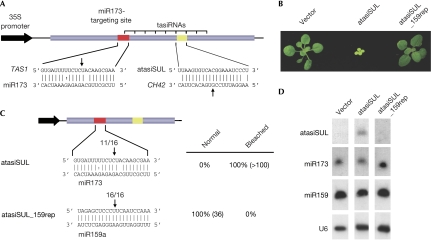Figure 1.
A target site for miR173, but not miR159, triggers the generation of trans-acting small interfering RNAs. (A) Diagram of TAS1a-derived TAS1-atasiSUL construct. The tasiRNA-spawning region is indicated by brackets, the miR173 target site is shown in red and the atasiSUL sequence in yellow. Arrows indicate expected miRNA-guided cleavage in the TAS1-atasiSUL transcript or atasiSUL-guided cleavage in its CH42 target. (B) Phenotype of atasiSUL-expressing plants. (C) Constructs testing miR173 and miR159 target site functionality. The numbers above arrows refer to the fraction of 5′ RACE products terminating at the canonical miRNA target site; the numbers of analysed plants are given in parentheses in the table. (D) Small RNA blot analysis; U6 was used as a loading control. atasiSUL, artificial (synthetic) tasiRNA-SULFUR; CH42, CHLORINA 42; miRNA, microRNA; RACE, rapid amplification of cloned ends; tasiRNA, trans-acting small interfering RNA.

